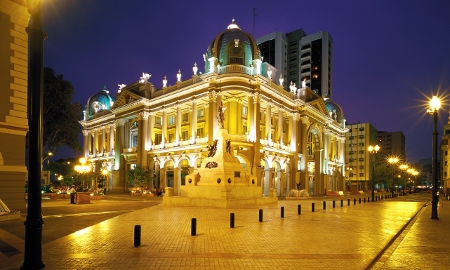Guayaquil’s Municipal Palace was designed in 1921 by the architect and engineer Maccaferri, and work was started by the company Italiana de Construcciones under the watchful eye of the Italian Juan Lignarolo. This was a time in which the design for the most important buildings of Latin American cities came from Europe, and depending on each municipality's or country's purchasing power the design would be acquired from France, Italy or Spain. The palace is also known as the "Cabildo de Guayaquil" and houses Guayaquil's city hall concentrating the political and economic management decisions regarding the city. It is built on what was the "Casa Consistorial" (the former town hall) that served as colonial council and was later demolished in 1908.
It is located in the city center's "Rocafuerte" sector and occupies the block between the streets known as Malecón Simón Bolivar, Pichincha, Clemente Ballén y Diez de Agosto. Separated only by a small park called Parque Sucre stands the building which houses the Governance of the Guayas Province. The monument on the Parque Sucre is known as the "Forge of Vulcan" represents the meeting which took place on Sunday October 1st of 1820 and the long process and the subsequent events that led to the independence of Guayaquil. Across the Malecon Simon Bolivar Avenue, is the waterfront embankment known as "Malecón 2000" where one can see the city's Moorish Tower. "Malecón 2000" is one of the largest public works carried out in the city and considered a model of urban regeneration by global standards, having been declared a healthy public space by the Pan-American Organization of Health (POH) and the World Health Organization (WHO).
Although very different to the Municipal palace, Guayaquil is home to other examples of Macaferri's architecture including the modernist "Casa Macaferri" and the restaurant known as "El Caracol Azul", both built in the 1930s and inspired by architects such as Loos or Le Corbusier who rejected the use of ornament, preferring pure shapes and intersecting geometries.

2 COMMENTS
Que belleza..
Woooah!! never expected Guayaquil to be like this, i had been told it was really ugly!! lol